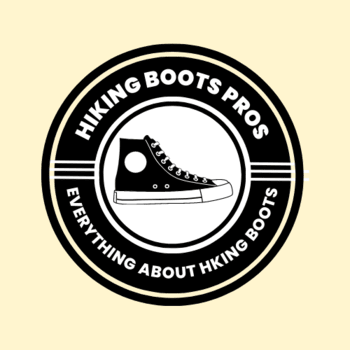Last updated on April 10th, 2023
Hiking is a popular outdoor activity that provides a great way to explore nature and stay fit. But to ensure that your hiking trip is enjoyable and safe, it’s essential to have the right footwear.
Hiking boots are usually designed for the demands of hiking. They provide support, protection, and stability that regular boots may not provide.
But what if you don’t have hiking boots and are wondering if you can use regular boots for hiking? Many people wonder if they can use their work boots for hiking. Or if there are specific types of hiking with regular boots.
In this blog post, we’ll be exploring the question of whether you can use regular boots for hiking.
We’ll be discussing the differences between hiking boots and work boots. This includes key features that make hiking boots more suitable for hiking.
We’ll also be looking at the types of hiking with regular boots, as well as the limitations that you may face.
Finally, we’ll be discussing the differences between hiking boots and work boots. We will be highlighting the key features that set them apart.
By the end of this blog post, you’ll know the importance of having proper footwear for hiking.
What Do You Need in Hiking Footwear?
Are you planning to hit the hiking trail anytime soon? Then, the first thing you should think about is your footwear.
Hiking can be a fun and rewarding experience, but only if you have the right shoes or boots. So, what do you need in hiking footwear? Let’s dive into the essentials.
First, consider the type of activity you’ll be doing. Will you be hiking through rough terrain or walking on a well-marked trail? This will help you determine whether you need hiking shoes or boots.

Hiking Boots
Hiking boots are for more challenging terrain or for carrying a heavy backpack. While hiking shoes are better for lighter activities.
Foot Support
Next, look for shoes or boots that offer good foot support. This is crucial in preventing injuries such as twisted ankles or plantar fasciitis. The shoes or boots should have sturdy soles that can handle rocky or uneven terrain. They should fit to prevent your feet from sliding around inside the shoes.
Protection
Besides foot support, protection is also important. Choose footwear that provides ample protection against hazards on the trail. Look for models with durable uppers made from leather or synthetic materials. Also, rubber toe caps help to prevent stubbed toes.
Grip
Finally, grip is key when it comes to hiking footwear. The shoes or boots should have a sole with good traction that can grip the ground, even when it’s wet or slippery. This is especially important when hiking on steep inclines or declines.
When choosing hiking footwear, consider the type of activity you’ll be doing. The foot support and protection you need, and the grip you need for the terrain.
Can You Use Regular Boots for Hiking?
Are you considering going on a hiking trip but don’t want to buy new footwear? You may be wondering if regular boots can suffice for hiking.
As someone who loves hiking and exploring the outdoors, I have some insight into this topic. Let’s dive in and find out if regular boots are suitable for hiking.
First, it’s important to understand that regular boots are not designed for hiking.
They are generally made for walking and everyday wear. While they may offer some level of comfort and support. They may not provide the necessary features for hiking.
When it comes to hiking, you need proper footwear that will keep you comfortable and safe.
Hiking footwear is usually designed to handle uneven and rugged terrain. It also provides traction and grip to help you maintain balance on slippery surfaces.
Also, to comfort and safety, hiking footwear also provides protection for your feet. Regular boots may not have the same level of protection. These boots may leave your feet vulnerable to injury from rocks, roots, and other debris on the trail.
Another important factor to consider is the type of socks you wear with your boots. Hiking socks provide extra cushioning, moisture-wicking properties, and breathability. This feature regular sock does not offer.
While regular boots may offer some level of comfort and support for walking. They are not the best choice for hiking.
If you’re planning on going on a hiking trip, it’s important to invest in proper hiking footwear. This will provide the necessary features for your safety and comfort. Don’t let footwear hold you back from exploring the great outdoors!
Can I Use Work Boots for Hiking?
The idea of wearing work boots for hiking might seem like a cost-effective option for many of us. If you already have a pair of sturdy boots that you wear to work, it makes sense to consider them for hiking as well, right?
Well, not exactly. While work boots may be comfortable and offer good foot support. They are not designed for hiking. Hiking involves walking on uneven terrain and steep inclines. Using regular boots or shoes for hiking can cause discomfort and foot injuries.
Here are some reasons why work boots may not be the best choice for hiking:
Traction and Grip:
Work boots usually have a flat sole that provides traction on flat surfaces. But lacks the necessary grip for hiking on rugged terrain. Hiking boots have specialized soles that offer better grip on wet surfaces.
Comfort:
Hiking boots provide the greatest comfort and support for long hikes. They have padding and cushioning to absorb shock and reduce pressure on your feet. Work boots may have thick and rigid soles that can cause fatigue and discomfort.
Durability:
Hiking boots can withstand the rigors of hiking and can last longer than regular boots. They have durable materials such as leather, nylon, or synthetic fabrics. These materials offer protection against wear and tear. Work boots, while sturdy, are not built for hiking and may not last as long as hiking boots.
Weight:
Hiking boots are lightweight and breathable. This makes them ideal for hiking in different weather conditions. Work boots may be heavier and lack proper ventilation. Improper ventilation can cause your feet to overheat and sweat.
What Type of Hiking Can I Do With Work Boots?
As someone who loves hiking, I know that the right footwear is crucial. The right footwear makes for a comfortable and safe experience. But what if you don’t have hiking boots? Can you use work boots instead? Let’s explore the answer to that question.
When it comes to hiking, there are different types of terrain and difficulty levels. Depending on the kind of hiking you’re planning to do, work boots may or may not be suitable.
For light hiking on easy terrain, such as a short trail through a park or a nature walk, work boots can be a good option. Work boots provide decent traction and support. They’re generally comfortable for short periods of time.
For more strenuous hikes or long distances, work boots are not recommended. They’re heavier than athletic shoes or trail runners. This can make it harder to hike for extended periods of time. Work boots also don’t offer as much flexibility, which can be a disadvantage on uneven terrain.
If you’re planning to mountaineer, you’ll need specialized mountaineering boots with crampon compatibility. These boots can handle the rigors of high-altitude hiking. It can also provide the necessary support and protection.
Hiking Boots vs Work Boots: 5 Differences
The great outdoors is full of surprises and adventures. For this, you need the right gear, including the perfect pair of boots. But with so many options out there, it can be overwhelming to decide what type of boots to wear for your hiking trip. In this blog section, I’ll break down the differences between hiking boots and work boots. So, you can choose the best option for your next adventure.
Durable
When it comes to durability, work boots are often the first choice. Made with tough materials such as full-grain leather. They can withstand harsh conditions and rough terrain.
Hiking boots are also durable but may not hold up as well as work boots over time. Hiking boots can handle the demands of hiking. It also offers the right balance of durability and flexibility.
Traction
One of the most important features of any outdoor footwear is the traction it provides. Work boots have a heavy-duty sole designed for the job site, which may not be ideal for hiking.
Hiking boots with a special sole provide excellent traction on various terrains. This ensures that you stay stable and balanced on your hike, reducing the risk of slips and falls.
Lightweight
When it comes to hiking, you want footwear that won’t weigh you down. Hiking boots are lightweight, allowing you to move on the trail.
Work boots are heavier and may slow you down on your hike. This extra weight can also cause fatigue and discomfort over time.
Flexible
Flexibility is key when it comes to hiking boots. Your feet need to be able to move to allow you to navigate the trail with ease.
Hiking boots provide the right amount of flexibility for hiking. Work boots are stiffer and may not allow for the same level of flexibility. This can make hiking more difficult and uncomfortable, especially on longer hikes.
Waterproof
Hiking can be a wet and muddy adventure, so it’s important to have footwear that can handle it. Hiking boots are often designed to be waterproof. Gore-Tex or other waterproof membranes that keep your feet dry and comfortable.
Work boots may not be waterproof, leaving your feet wet and uncomfortable on the trail.
Conclusion
When it comes to hiking footwear, it’s essential to choose the right type of shoe for the terrain.
While regular boots may be suitable for short, easy hikes on well-maintained trails. They are not recommended for more challenging terrain or longer hikes.
Using work boots for hiking may seem like a viable option, especially if you already have them. But, work boots are not designed for hiking. They lack the features necessary for a comfortable and safe hiking experience. They may also not provide enough traction on varied terrain.
The type of hiking you can do with work boots depends on the specific boots and the trail conditions. For easy hikes on flat, well-maintained trails, work boots may be suitable.
For more challenging terrain, choose hiking boots with good ankle support, and waterproof materials.
FAQs
Regular shoes can be for hiking on well-maintained trails or short, easy hikes. But they may not provide enough support and protection for challenging terrain.
Yes, hiking boots make a difference in providing support and protection for your feet.
If you don’t have hiking boots, opt for sturdy shoes with good traction and ankle support. These include trail running shoes or hiking sandals. Avoid open-toe shoes and shoes with flat soles.

Tyler Looney is an avid hiking enthusiast and the author of HikingBootsPros.com, a website dedicated to providing helpful insights and advice on choosing the best hiking boots. His expertise and passion for hiking have made him a valuable resource for both beginner and experienced hikers alike.

